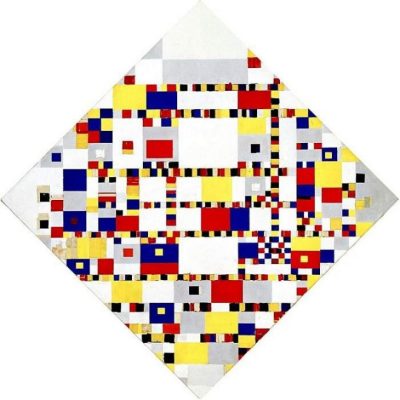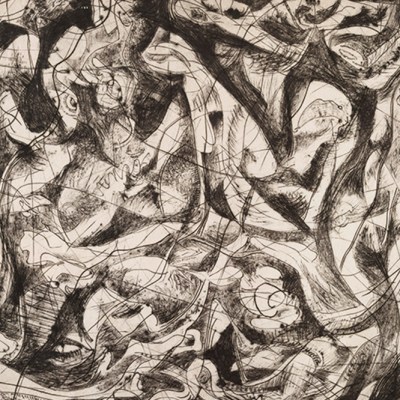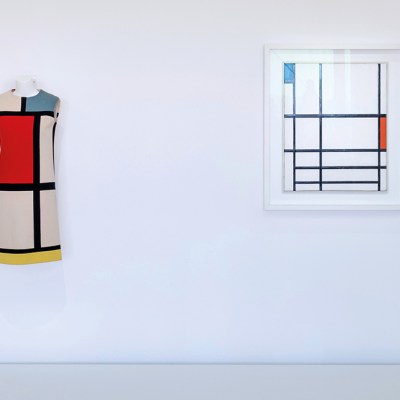From the June 2022 issue of Apollo. Preview and subscribe here.
In the Victoria and Albert Museum’s Department of Prints and Drawings is a small watercolour on paper called Roses in a Vase. It is, on the face of it, hardly a surprising work. As its title suggests, it shows five damask roses in a jar, a washed-out pink on the outside and oxblood in the middle. Faced with it in a slide test, you might hazard a sketch by Samuel Peploe or Laura Knight – at any rate, some aspirantly modern artist working in the years before the Great War. And you would be right as to date, although not to attribution. The watercolour is signed ‘Piet Mondrian’.
This makes Roses in a Vase rather more arresting. The V&A’s catalogue dates it as c. 1938–40, which is almost certainly wrong. If the watercolour was acquired by its donor in that time, it had been made at least ten years before, and very probably two decades before that.
Roses in a Vase is included in neither the Mondrian catalogue raisonné of 1998 nor its updated online version of 2018. It has never been published. In stylistic terms, the work’s nearest equivalent is Rhododendrons (catalogue raisonné number A617), provisionally dated 1909–10. That the V&A’s watercolour is signed ‘Mondrian’ rather than ‘Mondriaan’ suggests a slightly later date for it, though – after 1911, when the painter first moved to Paris and began systematically to drop the un-French second ‘a’ from his surname. Yet spelling is not an infallible guide. Mondrian’s signature had switched back and forth between Dutch and French orthographies before 1911, not least in those drawings of roses numbered C131 to C153 in the catalogue raisonné and dated from around 1909. Even with these, the artist’s signature varies between ‘P.’ and ‘Piet’, only two of the 23 rose drawings (C135 and C140) being signed with a full, block-capital ‘Piet Mondrian’. The latter drawing is the one that seems to relate most closely to the V&A’s painting, being made, like it, in watercolour and graphite. As often with Mondrian’s work, sleuthing gets one only so far.
Roses in a Vase (c. 1938–40, according to the V&A), Piet Mondrian, Victoria and Albert Museum, London. Image: © Victoria and Albert Museum

Were it not for the work’s lineage, it would be tempting to dismiss it as a fake. However, its provenance could hardly be more watertight. Roses in a Vase was given to the V&A by Count George (or, sometimes, Georg, Georgiy or Georgii Pavlovich) Bennigsen (also von Bennigsen), who had been given it by Mondrian.
Bennigsen had the cosmopolitan rootlessness of a character in The Waste Land. Born in St Petersburg in 1879 to a long-Russified family of Hanoverian nobility, he was taken prisoner by the Germans in 1914 at the disastrous Battle of Tannenberg. After the Russian Revolution of 1917, he fought the Bolsheviks as a lieutenant in the North Russian British Expeditionary Force – heroically, apparently, as he won both the Military Cross and Croix de Guerre. His movements over the next 20 years are obscure. However, by 1938 Count (or Graf) George Bennigsen was in London, writing about Byzantine Catholic church history and living with his wife, Olga Skaryatina, in the modest rooming house at 60 Parkhill Road, Belsize Park, NW3. In September of that year, Piet Mondrian moved into the same house.
It is clear that the two men, the Baltic aristocrat and the schoolmaster’s son from Amersfoort, became friends. Perhaps they had a shared sense of exile. On 9 September 1940, a German high-explosive bomb fell on the house next door, persuading Mondrian that the time had come to leave for America. He would die there of pneumonia three years later. Bennigsen seems to have stayed on in Parkhill Road. In November 1941, a year after Mondrian’s departure, he wrote to him in New York with news of their fellow lodgers. The house, Bennigsen said, was ‘practically empty’, Miss Donnelly, Miss Thorold, Mr. Gilchrist and Miss Sprake having ‘established themselves nearby’. ‘Our two young men also left, the studio being badly damaged,’ he went on. ‘Yes, we had bombs all around no. 60 and the garden was in a complete mess.’ Then, with a flourish of wartime bravado, he ended, ‘The house now has a better view as a corner house.’
Photograph of Georgiy Pavlovich Bennigsen and Olga Skaryatina Benningsen. Image: courtesy Jurij Cukanov
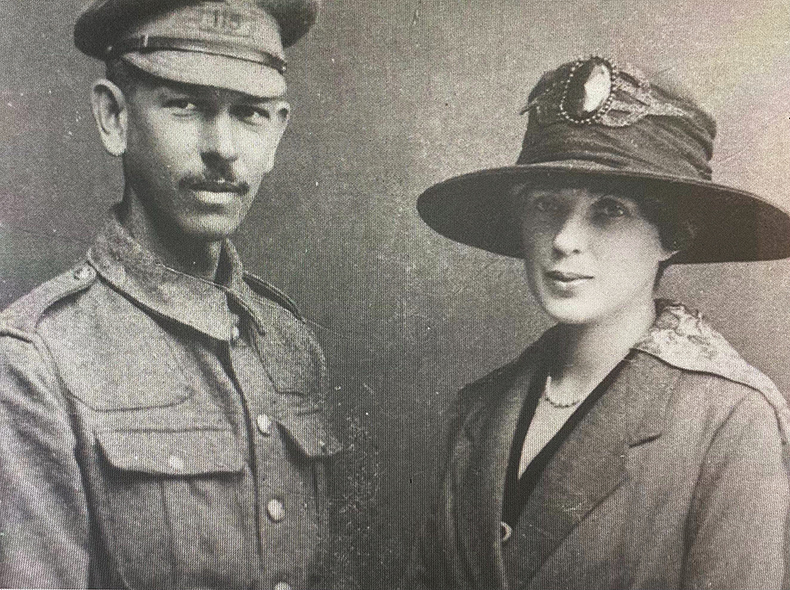
In the years since, Mondrian has changed by increments from man to metonym. He is his Compositions; his Compositions are modernity. Their combination of black grid and primary colours has proved extraordinarily versatile. The first Composition was painted more than a hundred years ago, the last nearly 80. Yet my local chemist in France sells two competing brands of cosmetics, each with its own Mondrianish packaging; the facade of a nearby chain motel is painted in blocks of red, yellow and blue. Mondrian is everywhere.
It is intriguing to speculate on what he would make of this. Neoplasticism, his one-man philosophy of art, was also a philosophy of life. Like the Gesamtkunstwerk teachings of Gropius’s Bauhaus, or Ozenfant and Corbusier’s Purism, it was meant to raze the boundaries between art, architecture and design. A Neoplastic world would be a more unified world, and a better one. Mondrian might have looked at the HotelF1 and nodded.
The problem is what the success of the Mondrian brand – a forgivable word, I think – has done to the way we see his art. If the cosmetics packaging and motel facades (and refrigerator magnets, and Yves Saint Laurent shift dresses, and so on, and on, and on) derive from works such as the Tate’s Composition B (No.II) with Red (1935), then the reverse is now also true. It is hard to look at a Mondrian grid painting from after 1919 without the vague sense of having seen it somewhere before.
This in turn encourages a misunderstanding of what the Compositions are. They seem simple, stylish, formulaic, commercial; easily won. They are none of those things. Their orderliness suggests scientific process, with Mondrian as a kind of painterly version of Evelyn Waugh’s Professor Silenus, measuring grids with a grim slide rule. The Compositions are freehand, Romantic, rough-edged and reworked again and again, sometimes for years.
Composition B (No. II) with Red (1935), Piet Mondrian. Tate, London
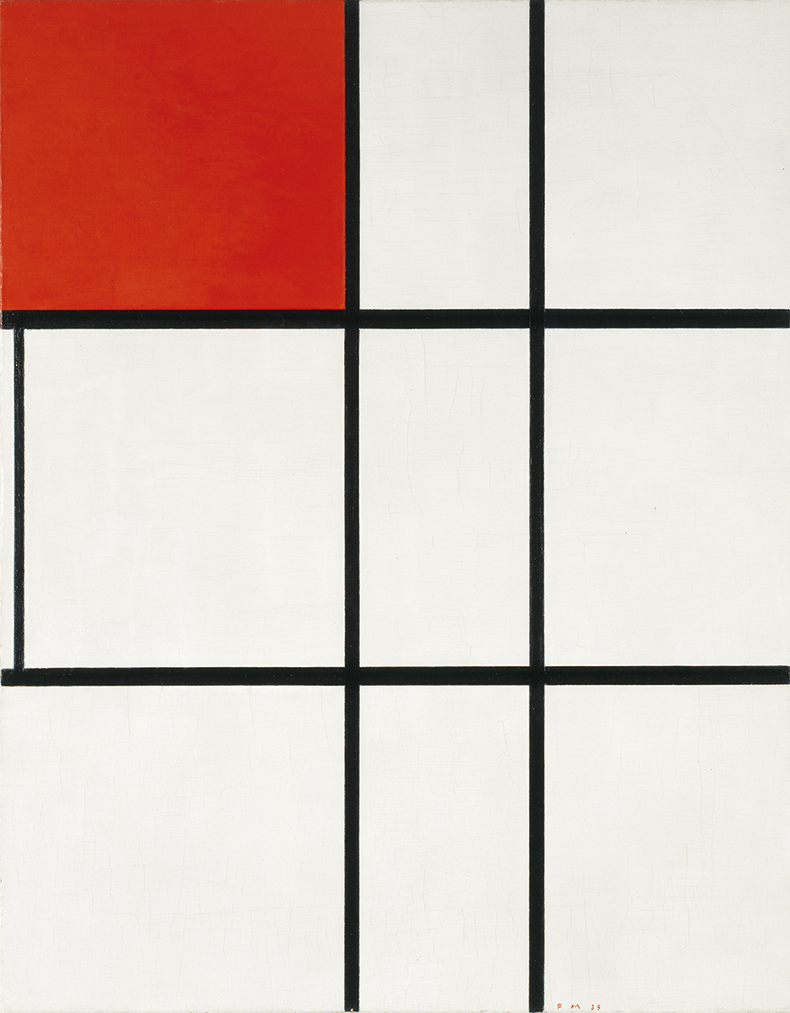
In this, the 150th anniversary of Mondrian’s birth, museums in Düsseldorf, Basel and The Hague will host major exhibitions of his work. My hope is that they will be messy. Galleries have tended to show his development with the inevitability of a time-lapse film: early academic realism melting into Theosophical expressionism, which is flattened by Cubism into grey trees with dark-dash branches; the dashes solidify into black grids, the squares and rectangles between them fade to white or fill with blue, red and yellow; et voilà. The implication is that the evolution of such linear works must likewise have been linear, which is very far from the truth.
It also raises questions about the usefulness of the word ‘abstract’ as used of Mondrian’s art. The idea that his grids started off as branches (or as city streets, another favoured contender) – that they are abstracted from these things – suggests that they linger on as an after-image in the post-1919 paintings. Look at Composition B (No.II) in the right way and for long enough and you might just see a tree or a map. In fact, the abstraction in a Mondrian is not literal but synaesthetic: what streets and branches suggested to him was not grids but syncopation, from which the name ‘composition’. The branches of The Grey Tree (1911) are present in Composition B (No.II) with Red only in the sense that a Sumerian ox-head is present in our pronouncing of the modern letter ‘a’. The way we think about Mondrian’s history needs roughing up.
Roses in a Vase is a good place to start. One satisfyingly untidy thing about the V&A’s watercolour is where and when it was given. By 1939, Mondrian had been making grid paintings for 20 years. To his English hosts, he played the part of dry urban rationalist. Winifred Nicholson, accompanying him on the train from Paris, had been surprised to see him gazing at the passing countryside; it turned out that he was admiring telegraph poles. Mondrian’s comment on being shown the view from the window of his new London studio by Nicholson’s husband, Ben, was a terse, ‘Too many trees.’ Yet some of this was play-acting, designed, successfully, to thrill.
The Grey Tree (1941), Piet Mondrian. Kunstmuseum Den Haag

Until the mid 1920s, coincident with the first Compositions, Mondrian had continued to draw and paint flowers, producing more than a hundred such works by 1926. ‘I enjoyed painting flowers,’ he recalled. ‘Not bouquets, but a single [one] at a time, in order that I might better express its plastic structure.’ Flowers proved a useful vehicle for experiment – with Theosophical Platonism, with the jagged outline of Van Gogh and the planar breaking-down of Braque. ‘I too find flowers beautiful in their exterior beauty,’ he said, ‘yet there is hidden within a deeper beauty.’ When, unexpectedly, he praised Winifred Nicholson’s flower paintings, it was more than just a favour returned. Mondrian saw them with the eye of a seasoned campaigner.
Roses in a Vase feels older than these late flowerings, though, which raises two questions. When Mondrian had taken the watercolour from Amsterdam to Paris in 1911, it was still at the forefront of his art. Its rough pencil underdrawing and jarring palette show him wrestling with Van Gogh, moving on from the traditional Dutch flower studies he had made in the late 1890s. But why, after two decades of grid paintings, had he thought to take Roses in a Vase to London? And why, once there, did he give it to a man he respected?
The second of these is probably the easier to answer: Bennigsen’s tastes ran to the conservative. Besides Mondrian’s roses, he owned 17th-century icons of the Virgin Panagia and an early English portrait of Peter the Great. In London, Mondrian had carried on painting Compositions such as Trafalgar Square (now in the Museum of Modern Art). His room at the back of the Parkhill Road house recreated the white-walled aesthetic of his studio in Montparnasse: in that Neoplastic way, it was both a place for making Mondrians and itself a Mondrian. Bennigsen was not anti-modern – he had written on Eric Gill for the Catholic magazine Blackfriars – but this was likely a step too far. It seems improbable that he would have understood Neoplasticism, or approved of it if he did.
If we hazard the watercolour as a leaving present in November 1940, then Roses in a Vase may have been chosen by its recipient. Mondrian had brought a dossier of works on paper with him from Paris in 1938; perhaps he allowed Bennigsen to pick what he liked from it. Or Roses in a Vase may have been given not to George Bennigsen but to his artistic wife, Olga, who, in 1926, had helped paint what is now the iconostasis of the Church of St Cyril of Turau in North Finchley. (It was originally made for Westminster Cathedral and moved to its new home in 2016.) In either case, the appeal of the watercolour would have lain in its orthodoxy.
Rhododendrons (1910), Piet Mondrian. Kunstmuseum Den Haag, The Hague

As to the first question – why had he taken the picture to London – Mondrian’s development as an artist was not, as curators have liked to suggest, a story of remorseless forward motion. Roses in a Vase is relatively large – roughly 25 cm square – suggesting that it was painted not in a sketchbook but as a finished work. Even after he had started his Parisian foray into Cubism, Mondrian would revisit these earlier paintings to see what could be mined from them: the Van Gogh-ish Rhododendrons (1909–10; A617) is repurposed as the Cubist Composition No. X (1912–13; B25). Images were not to be discarded but rescued. What he would have seen in Roses in a Vase in 1919 would not be what he had seen 30 years before. Now it was a rhythm of lines and voids, a syncopation.
If nothing is known of the circumstances of Mondrian’s gift to Bennigsen, then nor is it of the donation of Roses in a Vase, in 1957, to the V&A. Other than the date, there is no documentary record of it; no correspondence in the V&A archives, no condition report. If this seems remarkable, then note that Mondrian was very much less well known in 1957 than he is in 2022. The first exhibition of his work in a British public gallery – the Whitechapel – had taken place only two years before Bennigsen’s gift, in September 1955. Had he offered the V&A Mondrian’s watercolour in 1954, it might well have been turned down.
Why he should have parted with Roses in a Vase can likewise only be guessed at. In 1957, Bennigsen turned 78; his wife had died in London ten years before. As Mondrian had done, he would shortly leave for America, dying there in 1962. He may have made the gift to honour his late friend’s memory, or his wife’s, or in gratitude to the country that had rescued him, or as a way of avoiding US taxes. As Graf Georgiy Pavlovich Bennigsen, he is buried in the Novo-Diveevo Russian Orthodox Cemetery in Rockland County, New York. Olga Skaryatina Bennigsen’s grave is in East Highgate Cemetery, not far from Parkhill Road.
From the June 2022 issue of Apollo. Preview and subscribe here.
